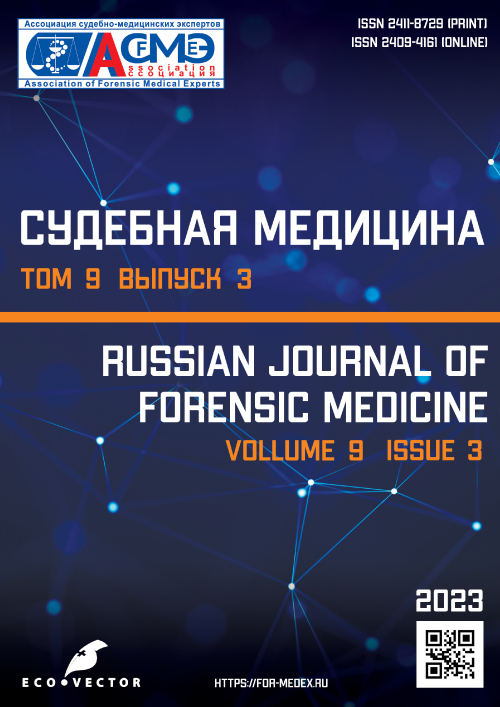Influence of alcohol intoxication on the survival period in patients with subdural hemorrhage
- Authors: Averkin N.S.1,2, Stolyarov A.P.1, Kharitonov E.A.1, Zhivankina I.S.2
-
Affiliations:
- Regional Bureau of Forensic Medical Examination
- Penza State University
- Issue: Vol 9, No 3 (2023)
- Pages: 269-278
- Section: Original study articles
- URL: https://journals.rcsi.science/2411-8729/article/view/148351
- DOI: https://doi.org/10.17816/fm7130
- ID: 148351
Cite item
Full Text
Abstract
BACKGROUND: Traumatic brain injury is an urgent problem in forensic medical examination, and subdural hematoma is considered the most fatal among them. In forensic medical practice, the outcomes of subdural hematoma should be understood depending on its volume to represent the pathohistological evolution of subdural hematoma and determine the essence of brain damage at the same time.
AIM: To evaluate the influence of alcohol intoxication on the survival period in patients with subdural hemorrhage.
MATERIALS AND METHODS: A retrospective study was conducted on 42 deaths from subdural hematoma, of which two groups were identified: those who died before medical care (n=20) and those who received medical care in a hospital (n=22). The injury circumstances, the blood volume spilled under the dura mater, the presence and degree of alcohol intoxication, and the level of consciousness on the Glasgow coma scale were recorded. Histological examination of a subdural hematoma was performed to determine its prescription.
RESULTS: Subdural hematoma is commonly caused by street injuries and traffic accidents. Hematomas are combined with skull fractures in 52.3% of cases, leptomeningeal hemorrhages in 73.8%, bruises in 81%, and cerebral edema in 88%. Unilateral subdural hematoma is more common than bilateral. The fact of alcoholic intoxication was recorded in most victims, whereas the ethyl alcohol concentration in the blood of persons who died before medical care was 2 times higher. Significant correlations were observed between the degree of impaired consciousness on the Glasgow coma scale and the concentration of ethyl alcohol in the blood (r=−0.701, p <0.05) and between the volume of subdural hematoma (r=−0.526, p <0.05) and hospitalization period (r=0.559, p <0.05).
CONCLUSION: Persons with subdural hemorrhage in a state of high degree of alcohol intoxication, as a rule, die before medical care is provided to them. Similarly, if help was provided, the outcome is most often unfavorable with a shorter survival period even in the presence of a small hematoma. Histological examination is currently the most optimal method in terms of determining the prescription of subdural hematoma.
Full Text
##article.viewOnOriginalSite##About the authors
Nikita S. Averkin
Regional Bureau of Forensic Medical Examination; Penza State University
Author for correspondence.
Email: averkin.n@list.ru
ORCID iD: 0000-0001-8129-9400
SPIN-code: 7973-2100
MD, Cand. Sci. (Med)
Russian Federation, Penza; PenzaArkadiy P. Stolyarov
Regional Bureau of Forensic Medical Examination
Email: sudmed_penza@mail.ru
ORCID iD: 0000-0001-6946-9059
SPIN-code: 3649-4766
MD, Cand. Sci. (Med)
Russian Federation, PenzaEvgeniy A. Kharitonov
Regional Bureau of Forensic Medical Examination
Email: haritonovdoc@mail.ru
ORCID iD: 0009-0004-2680-7432
SPIN-code: 9183-6366
MD, Cand. Sci. (Med)
Russian Federation, PenzaIrina S. Zhivankina
Penza State University
Email: izhivankina@list.ru
ORCID iD: 0000-0002-8927-2584
Russian Federation, Penza
References
- Monsivais D, Choi HA, Kitagawa R, et al. A retrospective analysis of surgical outcomes for acute subdural hematoma in an elderly cohort. Interdiscip Neurosurg. 2018;(14):130–134. doi: 10.1016/j.inat.2018.07.010
- Frolov IA, Frolov VV. Forensic evalution of the pathology and etiology of subdural hematomas. Russ J Forensic Med. 2015;1(2):51–52. (In Russ).
- Sivandzade F, Alqahtani F, Cucullo L. Traumatic brain injury and blood-brain barrier (BBB): Underlying pathophysiological mechanisms and the influence of cigarette smoking as a premorbid condition. Int J Mol Sci. 2020;21(8):2721. doi: 10.3390/ijms21082721
- Chmieliauskas S, Anuzyte JS, Liucvaikyte J, et al. Importance of effusion of blood under the dura mater in forensic medicine: A STROBE--compliant retrospective study. Medicine (Baltimore). 2018;97(39):e12567. doi: 10.1097/MD.0000000000012567
- Liu X, Gao C, Yuan J, et al. Subdural haematomas drain into the extracranial lymphatic system through the meningeal lymphatic vessels. Acta Neuropathol Commun. 2020;8(1):16. doi: 10.1186/s40478-020-0888-y
- Altaf I, Shams S, Vohra AH. Role of surgical modality and timing of surgery as clinical outcome predictors following acute subdural hematoma evacuation. Pak J Med Sci. 2020;36(3):412–415. doi: 10.12669/pjms.36.3.1771
- Anis SB, Khan SA, Mitha R, Shamim MS. Craniotomy or craniectomy for acute subdural hematoma? Difference in patient characteristics and outcomes at a tertiary care hospital. Asian J Neurosurg. 2022;17(4):563–567. doi: 10.1055/s-0042-1758842
- Aromatario M, Torsello A, D’Errico S, et al. Traumatic epidural and subdural hematoma: Epidemiology, outcome, and dating. Medicina. 2021;57(2):125. doi: 10.3390/medicina57020125
- Baucher G, Troude L, Pauly V, et al. Predictive factors of poor prognosis after surgical management of traumatic acute subdural hematomas: A single-center series. World Neurosurg. 2019;(126):944–953. doi: 10.1016/j.wneu.2019.02.194
- Akbik OS, Starling RV, Gahramanov S, et al. Mortality and functional outcome in surgically evacuated acute subdural hematoma in elderly patients. World Neurosurg. 2019;(126):1235–1241. doi: 10.1016/j.wneu.2019.02.234
- Poon MT, Rea C, Kolias AG, et al. British neurosurgical trainee research collaborative (BNTRC). Influence of antiplatelet and anticoagulant drug use on outcomes after chronic subdural hematoma drainage. J Neurotrauma. 2021;38(8):1177–1184. doi: 10.1089/neu.2018.6080
- Nedugov GV, Fedorina TA. New pathomorphological classification of subdural hematomas. Sci Innovations Med. 2020;5(2):130–135. (In Russ). doi: 10.35693/2500-1388-2020-5-2-130-135
- Bertozzi G, Maglietta F, Sessa F, et al. Traumatic brain injury. A forensic approach: A literature review. Curr Neuropharmacol. 2020;18(6):538–550. doi: 10.2174/1570159X17666191101123145
- Rao MG, Singh D, Vashista RK, Sharma SK. Dating of acute and subacute subdural haemorrhage: A histo-pathological study. J Clin Diagn Res. 2016;10(7):HC01-7. doi: 10.7860/JCDR/2016/19783.8141
- Dell’Aquila M, Maiese A, De Matteis A, et al. Traumatic brain injury: Estimate of the age of the injury based on neuroinflammation, endothelial activation markers and adhesion molecules. Histol Histopathol. 2021;36(8):795–806. doi: 10.14670/HH-18-319
- Li N, Du Q, Bai R, Sun J. Vitality and wound-age estimation in forensic pathology: Review and future prospects. Forensic Sci Res. 2018;5(1):15–24. doi: 10.1080/20961790.2018.1445441
Supplementary files









